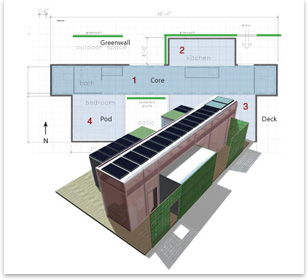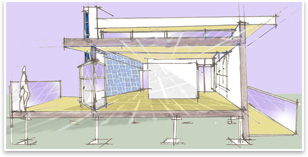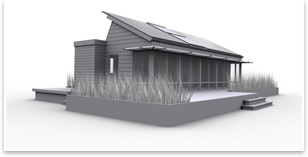|
Students Gear Up for Third Solar Decathlon
Contest takes place in October on the National Mall
 Summary: Twenty
college and university teams from 11 states as well as Puerto Rico,
Canada, Germany, and Spain will build individual, solar-powered houses
to create a “solar village” highlighting various sustainable
design techniques and tools promoting energy efficiency and renewable
energy exhibits this October on the National Mall in Washington,
D.C. Sponsored by the U.S. Department of Energy’s Office of
Energy Efficiency and Renewable Energy, the village will be open
to the public October 12–20. The contest, made especially timely
by current public interest in all things green, has architecture,
engineering, and communications students competing to “design,
build, and operate the most attractive, effective, and energy-efficient
solar powered house.” The AIA is one of the title sponsors
of the event. Summary: Twenty
college and university teams from 11 states as well as Puerto Rico,
Canada, Germany, and Spain will build individual, solar-powered houses
to create a “solar village” highlighting various sustainable
design techniques and tools promoting energy efficiency and renewable
energy exhibits this October on the National Mall in Washington,
D.C. Sponsored by the U.S. Department of Energy’s Office of
Energy Efficiency and Renewable Energy, the village will be open
to the public October 12–20. The contest, made especially timely
by current public interest in all things green, has architecture,
engineering, and communications students competing to “design,
build, and operate the most attractive, effective, and energy-efficient
solar powered house.” The AIA is one of the title sponsors
of the event.
 10 parts 10 parts
Although the decathlon is subsidized by DOE, teams raise funds from Solar Decathlon sponsors and other private sources to design, publicize, build, and compete. Rules dictate that houses be single-story, with optional lofts, and of about 800 square feet. Like its ancient Greek namesake, this decathlon sponsors competition in 10 parts. The contest categories for this year have been refined from years past:
- Architecture requires the teams to build houses that embody “firmness, commodity, and delight”; it is the only category in which contestants can earn up to 200 points
- Engineering awards students points based on engineering systems and viability and energy analysis (150 points)
- Market viability awards points based on how well and easily the design can be brought to market (150 points)
- Communications challenges teams to communicate their experiences to a wide audience through Web sites and public tours (100 points)
- Comfort Zone judges whether
the houses maintain a steady, uniform, comfortable temperature
and humidity throughout. Full points for this contest are awarded
for maintaining narrow temperature (72–76°F) and relative
humidity (40%–55%) ranges inside the houses (100 points)
- Appliances requires that
students maintain certain temperature ranges in their refrigerators
(34–40°F) and freezers (-20–5°F) during the
competition. They must wash and dry 12 towels for two days, cook
and serve meals to contest officials for four days, clean dishes
using a dishwasher for four days, and operate a TV/video player
for up to six hours and a computer for up to eight hours for five
days. Points are awarded for this contest through measurements
and task completion (100 points)
- Hot Water encompasses the “shower tests”; teams aim to deliver 15 gallons of hot water (110°F) in 10 minutes or less (100 points)
- Lighting allows teams to earn points by designing functional, energy-efficient, and aesthetically pleasing lighting systems (100 points)
- Energy Balance requires teams to use only the energy generated by their PV systems to provide all of the electricity for the contests; teams earn full points if the energy supplied to the batteries is at least as much as the energy removed from the batteries (100 points)
- Getting Around has student teams using electricity generated by their solar electric systems on their houses to charge their street-legal, commercially available electric vehicles; points are awarded based on how many miles each team completes (100 points).
 The overall winner will be announced October 20. The overall winner will be announced October 20.
This year’s Solar Decathlon is the third competition; the inaugural event was held in 2002, with the second decathlon in 2005.
|




